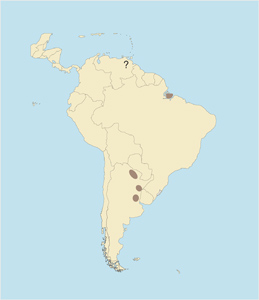Water Buffalo - South America | Online Record Book Preview
This is a preview of the Water Buffalo - South America species only.
Once you subscribe you will be able to view all the entry details for hundreds of different species, including full score sheets and photos.
This species has several classifications, to view each one you can click on the links below to jump down to that section:
Water Buffalo - South America |
 |
Bubalus bubalis
Búffalo acuático, Búffalo Asiático de agua (Sp), Wasserbüffel, Sumpfbüffel (G), Buffle d'eau, Buffle de l'Inde (F). Also called Asian water buffalo or Indian buffalo. Some authorities distinguish between the domestic (including feral) water buffalo as Bubalus bubalis and the wild water buffalo as B. arnee, while others, including ourselves, do not differentiate. As it was the domestic form that was first described for science, the name bubalis Linnaeus, 1758 takes precedence.
DESCRIPTION A large, heavily built, oxlike animal with stout legs, large, splayed hoofs, a large head and a large, hairless muzzle. The ears are relatively small and lightly haired. The tail reaches to the hocks and ends in a small tuft. Coloration is normally black or gray with the lower legs a dirty white. The coat is moderately long, coarse and sparse, with the hairs directed forward from hindquarters to head. The horns (both sexes) are heavy at the base, triangular in section, flat on top with conspicuous wrinkles, and grow out from the sides of the head without forming a boss, in a variety of configurations. The horns of the female are rounder and slimmer than those of the male, but are sometimes considerably longer.
DISTRIBUTION Free-ranging on Marajó Island in the mouth of the Amazon River in Brazil, and in Corrientes province in northeastern Argentina (since 1900). Also on private ranches in Argentina. Several imports of domestic stock were made in Venezuela between 1935-1940; some of these escaped to the wild but are believed to have been killed off.
REMARKS Wild water buffaloes were once widespread in southern Asia, but have disappeared from most of their original range, occurring now only in parts of Nepal and northeastern India in greatly reduced numbers, and are listed as endangered. They were domesticated about 4,000 years ago and have been widely introduced outside their natural range. Today, at least 130 million are found throughout the world in warmer climates, both as domestic and feral animals. There are no biological differences between the wild and domestic varieties, as the genus does not interbreed with domestic cattle; however, the domestic water buffalo may be smaller and have smaller, more tightly curled horns. The water buffaloes introduced in South America are of the domestic type.
|
Classifications
Water Buffalo (free range) - Species Detail |
| Scientific Name: |
Bubalus bubalis |
Gold: |
91" |
Gold (Bow): |
87 4/8" |
| AKA: |
Asian water buffalo |
Silver: |
83 5/8" |
Silver (Bow): |
77 7/8" |
| Endangered: |
|
Bronze: |
75" |
Bronze (Bow): |
66 7/8" |
| Member |
Taken |
Location |
Hunting Company/Guide |
Measurer |
MOK |
Score |
OR |
MR |
The Water Buffalo (free range) currently has 302 Entries listed in the SCI Record Book!
Once you subscribe you'll be able to access photos and full socre sheets for all of these entries. Plus you can filter, sort, and search through all species and entries in the SCI database. If you would like to subscribe now to have access to the entire database, please click here.
|
Return to Top
Water Buffalo - Species Detail |
| Scientific Name: |
Bubalus bubalis |
Gold: |
89 3/8" |
Gold (Bow): |
70 5/8" |
| AKA: |
Asian water buffalo |
Silver: |
82 4/8" |
Silver (Bow): |
0" |
| Endangered: |
|
Bronze: |
75" |
Bronze (Bow): |
67" |
| Member |
Taken |
Location |
Hunting Company/Guide |
Measurer |
MOK |
Score |
OR |
MR |
The Water Buffalo currently has 147 Entries listed in the SCI Record Book!
Once you subscribe you'll be able to access photos and full socre sheets for all of these entries. Plus you can filter, sort, and search through all species and entries in the SCI database. If you would like to subscribe now to have access to the entire database, please click here.
|
Return to Top
|




